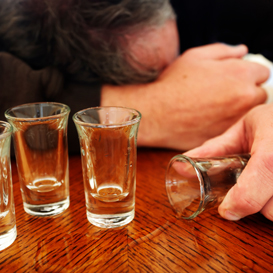 Alcohol affects people differently depending on their size, sex, body build, and metabolism. General effects of alcohol are a feeling of warmth, flushed skin, impaired judgment, decreased inhibitions, lack of muscular in coordination, slurred speech, and memory and comprehension loss. In states of extreme intoxication, vomiting is likely to occur and may be accompanied by incontinence, poor respiration, and a fall in blood pressure. In cases of severe alcohol poisoning coma and death can occur.
Alcohol affects people differently depending on their size, sex, body build, and metabolism. General effects of alcohol are a feeling of warmth, flushed skin, impaired judgment, decreased inhibitions, lack of muscular in coordination, slurred speech, and memory and comprehension loss. In states of extreme intoxication, vomiting is likely to occur and may be accompanied by incontinence, poor respiration, and a fall in blood pressure. In cases of severe alcohol poisoning coma and death can occur.
Drinking heavily over a short period of time usually results in a “hangover” – headache, nausea, shakiness, and sometimes vomiting. These side effects begin from 8 to 12 hours later. A hangover is due partly to poisoning by alcohol and other components of the drink, and partly to the body’s reaction to withdrawal from alcohol.
Combining alcohol with other drugs can make the effects of these other drugs much stronger and more dangerous. Many accidental deaths have occurred after people have used alcohol combined with other drugs. Cannabis, tranquillizers, barbiturates, sleeping pills, or antihistamines (in cold, cough, and allergy remedies) should not be taken with alcohol. Even a small amount of alcohol with any of these drugs can seriously impair a person’s ability to drive a car or make sound decisions.
People who drink on a regular basis become tolerant to many of the unpleasant effects of alcohol, and thus are able to drink more before suffering these effects. Yet even with increased consumption, many such drinkers don’t appear intoxicated. Because they continue to work and socialize reasonably well, their deteriorating physical condition may go unrecognized by others until severe damage develops. It may take hospitalization for unrelated reasons for alcohol abuse to show up as they suddenly experience alcohol withdrawal symptoms.
Psychological dependence on alcohol may occur with regular use of even relatively moderate daily amounts. It may also occur in people who consume alcohol only under certain conditions, such as before and during social occasions. This form of dependence refers to a craving for alcohol’s psychological effects, although not necessarily in amounts that produce serious intoxication. For psychologically dependent drinkers, the lack of alcohol tends to make them anxious and in some cases even panicky.
Physical dependence occurs in consistently heavy drinkers. Since their bodies have adapted to the presence of alcohol, they suffer withdrawal symptoms if they suddenly stop drinking. Withdrawal symptoms may include jumpiness, sleeplessness, sweating, and poor appetite, to tremors (the “shakes”), convulsions. hallucinations. and sometimes death.
Alcohol abuse can take a negative toll on people’s lives, fostering violence or a deterioration of personal relationships. Alcoholic behavior can interfere with school or career goals and lead to unemployment.
Long term alcohol abuse poses a variety of health risks, such as liver damage and an increased risk for heart disease. Fetal Alcohol Syndrome may result from a pregnant woman’s use of alcohol. This condition causes facial abnormalities in the child, as well as growth retardation and brain damage. Fetal Alcohol Syndrom is often manifested by intellectual difficulties or behavioral problems.
It is the concentration of alcohol in the blood that causes the effects. In the following table, the left-hand column lists the number of milligrams of alcohol in each deciliter of blood – that is, the blood alcohol concentration, or BAC. (For example, an average person may get a blood alcohol concentration of 50 mg/dL after two drinks consumed quickly.) The right-hand column describes the usual effects of these amounts on normal people – those who haven’t developed a tolerance to alcohol.
